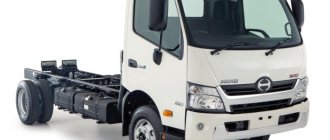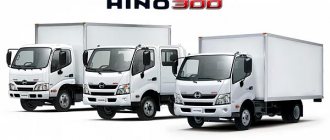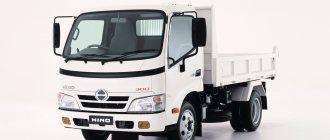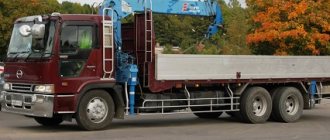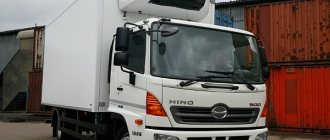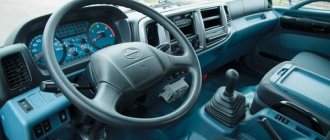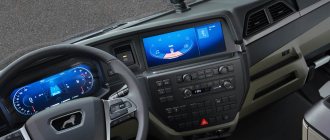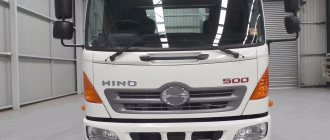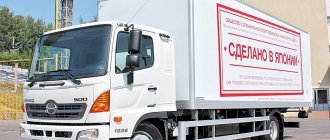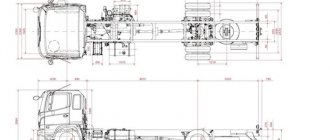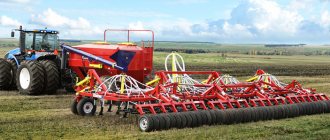Hino 300 is a family of light-duty trucks from Hino Motors Ltd., which is part of the famous Toyota brand. The models in the series have all the qualities necessary for a commercial truck. You can install various add-ons on the Hino 300 chassis, getting the necessary modification of the car with an attractive appearance at the best price.
The model is considered a modern “relative” of the Toyota Dyna, popular among Russians. Hino 300 trucks are adapted for use in difficult road and climatic conditions.
By choosing Hino 300, the consumer receives:
- powerful Japanese unit;
- good combination of high load capacity and compactness;
- modern security system;
- rugged chassis.
About the manufacturing company
In fact, Hino Motors, Ltd. is one of Japan's largest manufacturers of trucks and buses. For more than forty years in a row, HINO has been a leader in sales of medium- and heavy-duty trucks in Japan. The company was founded in 1942 and was called HINO Heavy Industry Co., Ltd. and was engaged in the production of large diesel power units for marine vessels.
Since 1948, it changed its name to Hino Diesel Industry Co., Ltd., and the direction of its activities - to the production of trucks, buses and diesel engines for them. It also produced passenger cars. In 1967, it became part of the Toyota company, becoming its “cargo department”.
The name HINO 300 has been common since 1999, when mass production of the updated series of HINO Dutro trucks was launched. At the end of 2007, the sales volume of HINO trucks abroad for the first time exceeded the sales volume in the domestic market of Japan. The total number of cars supplied for export reached 1,000,000 units.
Since 2008, a distribution company has been operating in Russia. Its partner network includes more than thirty dealer enterprises that sell HINO cars, supply auto parts for them, and carry out maintenance and repairs. The company has offices in Moscow and in the Primorsky Territory (city of Artyom). The total number of new Hino trucks sold in Russia during this time is more than 10 thousand units.
There are three series of HINO brand trucks on the Russian market: 300, 500 and 700. Series 300 is the lightest, environmentally friendly and in demand among Russian buyers.
Modifications
The new HINO 300 trucks are sold in Russia in two modifications: 3615 and 3815. The first of these modifications contains three wheelbase options, and the second - four, which makes it possible to choose from seven vehicle options, with overall chassis lengths from 4.7 to 7.285 meters . In this regard, there are many options for add-ons to equip the chassis, and this makes the 300 series cars truly versatile. The digital indices of models 3615 and 3815 are deciphered as follows: the first digit indicates the series - 300, the second - the rounded value of the total weight (5.5 and 7.5 tons), the last two digits - the number of tens of horsepower (the power of a standard diesel engine is 150 hp. ). At the same time, the 3615th version is certified in Russia as a truck with a gross weight of not 5.5, but 3.5 tons (driver’s license B).
There are three variants of the 3615: XZU600L-HKMMPW3, XZU640L-HKMMPW3 and XZU650L-HKMMPW3. They differ: wheelbase length: 2.525 m; 2.8 m or 3.4 m respectively;
- overall length dimensions: 4.7 m; 5.19 m; 5.965 m;
- rear overhang size: 1.135 m; 1.375 m; 1.555 m;
- chassis load capacity: 1,361 t; 1,323 t; 1,278 t;
- turning radius size: on wheels – 5.2 m; 5.7 m; 6.8 m, from wall to wall - 5.8 m; 6.3 m; 7.4 m.
The cabin for all variants of this modification is narrow, single-row, three-seater. The wheel formula for any of the options is 4x2.
- The technically permissible load on the front axle is 1.9 tons, on the rear axle – 2.6 tons.
- The width of the car is 1.855 m; height – 2.1 m.
- The chassis height at the front is 625 mm; The chassis height at the rear is 695 mm.
- Ground clearance on the rear axle is 160 mm.
- The front wheel track is 1.4 m; rear wheels – 1.435 m.
There are four variants of the 3815: XZU710L−HKFRPW3, XZU720L−HKFRPW3, XZU720L−QKFRPW3 and XZU730L−HKFRPW3.
They differ:
- wheelbase length: 3.43 m; 3.87 m (in two medium versions) and 4.2 m;
- overall length dimensions: 6.12 m; 6.735 m; 7.285 m;
- rear overhang size: 1.56 m; 1.76 m; 1.94 m;
- chassis load capacity: 4.95 t; 4.935 t; 4.735 t; 4.9 t;
- turning radius size: on wheels – 5.8 m; 6.4 m; 6.9 m, from wall to wall - 6.5 m; 7.1 m; 7.6 m.
The cabin for all variants of this modification is wide, single-row, three-seater. In addition to the XZU720L−QKFRPW3 option: there is a double wide cabin, with an additional row of seats, seven-seater. The wheel formula for any of the options is 4x2.
- The technically permissible load on the front axle is, respectively: 2.492 t; 2,566 t; 2.6 t; 2,034t. Rear axle – 5.008 t; 4.934 t; 4.9 t; 5,466 t.
- The width of the 3815 is 1.995 m; height – 2,215 m (with single cabin) and 2,240 m (with double cabin).
- The chassis height at the front is 705 mm; The chassis height at the rear is 795 mm.
- Ground clearance on the rear axle is 190 mm.
- The front wheel track is 1.655 m; rear wheels - 1.52 m.
Fuel consumption rates
I bring to your attention a table with fuel consumption rates for ISUZU
.
| Model ISUZU | Chassis, l/100 km | Van (empty), l/100 km | Van (vehicle loaded), l/100 km |
| NLR85 | 10,7 | 12,1 | 13,6 |
| NMR85 | 11,5 | 12,8 | 14,4 |
| NPR75 | 13,0 | 14,1 | 15,7 |
| NQR90 (155 hp) | 14,0 | 15,2 | 16,9 |
| NQR90 (190 hp) | 14,5 | 15,7 | 17,5 |
| FSR90 | 19,7 | 21,2 | 24,0 |
| FVR34 | 21,5 | 23,5 | 26,0 |
| CYZ52 | 28,0 | 30,0 | 35,0 |
| EXZ52 (tractor) | — | 28.0 (without trailer) | 36.0 (with trailer) |
The data in the table is presented taking into account the available information based on the results of various tests, surveys of dealers and customers operating ISUZU cars.
It should be noted that fuel consumption standards do not take into account: - additional equipment installed on the vehicle. For example, refrigeration and heating equipment, the drive of which also requires additional fuel consumption; — operating a car in a city with a population of more than 1 million people; — operating a car in winter; - operating a vehicle with frequent stops; — operation in mountainous areas. For all these operating conditions, there are correction factors that are determined in accordance with the Order of the Ministry of Transport of Russia dated March 14, 2008 No. AM-23-r.
In August 2014
Conducted a comparative test drive.
This test drive involved an ISUZU NPR75LK
with a van. One of the parameters that was compared in the last test drive was fuel consumption. You can watch a video of this comparison test:
Engine HINO 300
The engine on all modifications of Hino 300 trucks is the same. This is a four-cylinder in-line diesel engine N04C-UV, produced by HINO. It has a displacement of 4009 cm3, is equipped with a turbocharger, an intercooler, an exhaust gas recirculation system, and a Common Rail electronic injection system. The piston stroke is 118 mm and its diameter is 104 mm. The camshaft is located in a cast iron block. It is important that the cylinder liners are removed quite simply, without serious effort, special devices and tools.
Diesel N04C−UV complies with the Euro-4 environmental standard. The EGR exhaust gas recirculation system helped achieve a higher level of environmental safety compared to the previous modification.
In cars of the most recent years of production, the N04C−UV engine was brought to the Euro-5 environmental standard by using a DPR particulate filter. with a manual regeneration mode that extends its service life.
The maximum power of the N04C−UV engine after updating the HINO 300 series in 2011 increased to 150 horsepower (110 kW), at 2500 rpm. In the previous modification in 1999, it was 138 horsepower. The maximum torque is 420 N•m at 1400 rpm (this figure was previously 396 N•m). The increase in power was achieved thanks to an improved fuel system and updated compressor settings.
The turbine, manufactured by Garret, is equipped with an electronic adjustment mechanism. The fuel equipment on the updated modifications of HINO 300 is from the Japanese company Denso. A three-stage diesel fuel filtration system is used, with electrically heated separator and main filter.
A layer of polyamide applied to the piston skirt reduces friction, which improves piston performance when the engine is overheated. The fan drive device allows you to save fuel when driving during severe frosts and while warming up the diesel engine. The average diesel fuel consumption of trucks of the 3615th modification is, according to the manufacturer, 16.8 liters per 100 kilometers, and of the 3815th modification – 17.2 liters per 100 kilometers. A 70-liter fuel tank is installed on the XZU600L−HKMMPW3 variant. For all others - 100-liter.
Design
The design of the Hino 300 cannot be called interesting or attractive. The 300 series was originally created for the transportation of small and medium-sized cargo. At the same time, the manufacturer set out to create the most budget version. That's why you won't find any designer delights here. Any description only includes focusing on functional parameters and technical capabilities.
However, it cannot be said that the model cannot interest anyone. There are features that are worth paying attention to. But every detail is endowed with a functional purpose by the manufacturer.
Exterior
When you first meet the model, what immediately catches your eye is that the Hino 300 has a large, wide cabin. Large doors and steps provide convenient and easy access to the interior. But the fact that the rise is not too high may seem like a minus for some, because driving on Russian roads during bad weather can be difficult.
As for color solutions, everything is simple here - the variations are presented in white.
The latest models have better streamlining. Thanks to this, increased aerodynamics are achieved, which ensures not only a comfortable ride and less shock when driving, but also reduced fuel consumption. This became possible due to the fact that the edges of the body have become much smoother compared to previous versions.
The Hino 300 headlights deserve special attention. Fog lighting is an innovation characteristic of the latest models. Thus, visibility at night improves, which is sometimes key when choosing a car option for long trips.
Interior
The Hino 300 car is distinguished by its extreme simplicity and this also applies to the interior. The cabin has only the minimum necessary features. This is quite enough for normal comfortable work of the driver. At the same time, the cost can be reduced significantly.
For example, the fact that the seats are covered with gray fabric makes the model cheaper. But the driver will be able to purchase leather covers at any time, choosing them according to his taste.
There are 3 seats in the cabin. The driver's seat is equipped with a backrest tilt and height adjustment function. The steering wheel can also be adjusted in height. If necessary, it is additionally possible to install airbags for passengers, since initially only the driver's airbag is provided. The airbag is mounted in the steering column.
If necessary, the middle seat can easily be transformed into a comfortable table by simply folding it. There are also many pockets and shelves in the cabin, as well as bottle holders, ashtrays, a glove compartment, and a side compartment for papers on the door. The reason is that the model is used by freight forwarders, so the main emphasis when creating it is to make their work easier.
The front panel is black and lacks modern additions (on-board computer, touch panel). There is a standard monitor on which the engine temperature, the volume of diesel in the tank, and mileage are noted. In older models there is no monitor - there are only pointer sensors.
In the latest model, the cabin has become much longer, larger and more spacious, and the doors have also become larger. In addition, it is worth noting a pleasant innovation - the gear shift lever is now located not in the middle, but closer to the driver’s seat. In addition, if necessary, it can be completely folded. This will make it easier to move around the cabin and will make it much easier to equip a berth in the cabin.
Transmission
Trucks of modification 3615 (3.5 t) are equipped with a five-speed manual gearbox. She is completely synchronized. Model – M550 (Aisin). The gear ratios of this manual transmission are as follows: 1st gear: 4.981; 2nd: 2.911; 3rd: 1.556; 4th: 1,000; 5th: 0.738; reverse gear: 4.625. The final drive ratio is 4.875.
Cars of modification 3815 (7.5 t) are equipped with a six-speed manual gearbox МYY6S (Isuzu). The gear ratios of this manual transmission are: 1st gear: 5.979; 2nd: 3.434; 3rd: 1.862; 4th: 1.297; 5th: 1,000; 6th: 0.759; reverse gear: 5.701. The final drive ratio is 4.625.
A favorable range of gear ratios makes it easy to move off under load in first gear, and 2-5 gears provide smooth dynamic acceleration and movement in optimal economical mode.
The aluminum crankcase contributes to the best running of bearings and durability of parts. A distinctive feature of HINO 300 gearboxes is an efficient synchronizer. Gear shifting is carried out using cables. Relatively low fuel consumption is ensured by a combination of a modern and efficient gearbox, a fairly powerful engine and a high-quality gearbox.
The clutch on any of these machines is single-disk, dry, diaphragm type, with a hydraulic drive and a vacuum booster. The aperture diameter is 325 mm.
Brake system
The main brake system of HINO 300 trucks is hydraulic, dual-circuit, with a vacuum booster. Both front and rear brakes of all cars of this model are ventilated discs. This makes the HINO 300 machines stand out from many of their other Asian classmates. The brakes are quite informative and tenacious. Replacing the pads does not require serious effort.
The parking brake is of a drum type, with a mechanical drive. There is an auxiliary mountain brake. The braking system is equipped with safety systems: ABS (Antilock Brake System) - anti-lock braking system, EBD (Electronic Brake force Distribution) - electronic brake force distribution system, VSC (Vehicle Stability Control) - exchange rate stability system, ASR (Anti Slip Regulation) - anti-slip system.
The presence of an engine retarder allows the driver to save the life of the brake pads not only on long descents, but during intra-city operation.
TOTAL WEIGHT 8 T | CHASSIS XZU7
The use of a modern Common rail power system, a variable geometry turbocharger, an exhaust gas recirculation system and an active particulate filter DPR made it possible to ensure compliance with modern Euro 5 environmental safety requirements, while maintaining fuel efficiency and power characteristics at a high level. Cabs for the HINO 300 family are designed using the EGIS Emergency Guard Impact Safety system. Protection of the driver and passengers in the event of a frontal impact.
Suspension and chassis
Clear differences between the modifications of the HINO 300 series trucks can be seen when taking a quick look at the chassis. The number of studs for fastening the wheels immediately catches your eye: the 3615 has five, and the 3815 has six. A wider frame is also made for the 7.5-ton model. All Hino 300 series trucks are equipped with multi-leaf springs. The width of the front package, consisting of six sheets, is 70 mm and the thickness is 10 mm. The back sheets are the same width, but they will be thicker. Good handling and stability with a load are provided by anti-roll bars installed on the front axle.
Suspension types: front - dependent, on semi-elliptical leaf springs, with hydraulic shock absorbers and anti-roll bar; rear - dependent, on semi-elliptical leaf springs, with hydraulic shock absorbers. The spring suspension has confirmed its reliability and durability through many years of operation in Russia.
Tire size and load indexes:
- R630 195/75R16C 110/108 (3615th option) and
- RY023215/75R17.5 126/124 (for 3815).
Hino 300 truck cab
Cabs for the HINO 300 family are designed using the EGIS (Emergency Guard Impact Safety) safety system. A driver airbag is standard. The basic equipment also includes central locking, heated two-piece side-view mirrors with electrical adjustment, and a steering column with tilt and reach. The luxury package includes air conditioning and a radio with USB.
The cabin, compared to the previous family of the 1999 model, has become longer. This allows you to move the chair further back. The aerodynamic performance was improved due to a greater slope of the windshield. The headlights were increased in size, and the foglights became round. Headlights are halogen, with tilt angle corrector. Fog lights are LED. The doorway became wider and higher.
The opening is wide enough, the footrest and handrail are comfortable. Due to this, getting into the driver's seat is quick, easy and comfortable. The ergonomics of the driver's workplace are well thought out. All controls are located at hand, there is no need to reach anywhere. The instrument cluster on the front panel is extremely simple and clear. The cabin has a large number of various glove compartments and drawers, there is a shelf that stretches along the entire length of the front panel, plus two mezzanines in the upper part of the cabin. There is a place for tools behind the back of the passenger seat.
An important aspect of the cabin equipment: the gear shift lever can be folded. To do this, you just need to pull it up and bend it to the right. As a result, it will not interfere with free movement around the cabin, and, on occasion, will allow the driver to sleep. The parking brake lever is also foldable. When the car is parked on the handbrake, the lever is raised up as usual, but when you press the button it freely falls down, and the system remains activated during this folding.
For maintenance or repairs, the cabin can be easily and quickly tilted manually, for which you need to release the lock latches using the handles.
Device
Hino 300, depending on the version, is equipped with various transmissions. For modifications 3615, Aisin gearboxes are used, for versions 3815, Isuzu gearboxes are used. At the same time, the power plants used are the same, therefore the clutch on all versions is single-plate with a hydraulic drive and a diaphragm diameter of 325. Lighter cars are equipped with 5-speed synchronized Aisin M550 gearboxes, heavier ones are equipped with 6-speed Isuzu MYY6S gearboxes (Isuzu NPR has similar transmissions). Thanks to the aluminum crankcase, the durability of the parts and the best running of the bearings are ensured. A special feature of the gearbox is a high-efficiency synchronizer; gear shifting is performed using cables.
Hino 300 is available exclusively with two axles. The brand does not produce all-wheel drive modifications. The greatest differences in truck versions appear in the chassis. Version 3615 uses 5 studs to secure the wheels, version 3815 uses 6 studs. The 8-ton variation uses a wide frame. All modifications of the series are equipped with multi-leaf springs with thicker rear leaves. Thanks to anti-roll bars, good handling is achieved.
The truck is equipped with disc brakes, which distinguishes it from competitors made in Korea, Japan and China. These brakes stand out for their tenacity and informativeness. You don't need to put in a lot of effort to replace the pads. The disadvantages of the braking system include the outdated parking brake. When using it for an emergency stop, a strong vibration begins to be felt on the car, which causes discomfort.
The cabin of the latest generation Hino 300 has become noticeably longer. By increasing the slope of the windshield, aerodynamic performance was increased. Improvements have led to a reduction in fuel consumption. Changes also affected the radiator grille and headlights. The new rear wall made it possible to move the driver's seat back if necessary. The doorway has increased in height and width.
The gear shift lever has become more convenient. It was placed not in the middle of the cabin, but closer to the driver. Another innovation was the increased functionality of the lever, which became foldable. Due to this, you can now sleep in the cabin. This innovation made it easier to move around the cabin. Two drawers for documents and personal belongings appeared on the cabin ceiling. The dashboard has also been modernized. It has increased in size, and a display with sensors for fuel level, engine temperature, mileage and fuel consumption has been added to the standard arrow indicators. An airbag appeared, increasing the degree of driver protection.
Other design features of the model include:
- heated 2-piece mirrors;
- ABS;
- electric windows;
- EBD;
- front stabilizer bar;
- 3-point seat belts;
- steering column with shock absorption;
- safety steering wheel;
- a wide range of colors of materials used to decorate the interior and seats;
- ease of maintenance and durability of components;
- anti-corrosion coating that allows you to maintain a beautiful appearance for a long time;
- durable body.
It is no coincidence that the Hino 300 is one of the most popular light-duty trucks on the domestic market. The car has practically no shortcomings. Its main disadvantage remains the lack of an extensive network of dealers and service centers. This makes the machine quite expensive to repair and maintain. Spare parts for the Hino 300 in the European and central parts of Russia cannot always be purchased in a short time, and their cost is quite high. This is precisely what is stopping the mass distribution of the car on the Russian market.
Reviews of HINO 300 trucks
The experience of using vehicles of this family in Russia has demonstrated that these trucks are built with high quality, at a high technical level. At the same time, they are quite simple in their design, as well as in maintenance and operation. An advantage is that all of these machines, without exception, are produced in Japan, and the production culture there is traditionally much higher than that of China and other Asian ones. The downside is the expensive price compared to Chinese and Korean “classmates”.
Owners speak of the Hino 300 as a nimble and maneuverable truck for commercial cargo transportation. It is possible to install any add-on on the HINO chassis of this series. Sound insulation in the cabin is very decent, visibility is almost the maximum possible. Two-piece mirrors minimize any blind spots. Thermal insulation and heating cope well with winter cold. The cabin is warm, but it is uncomfortable to sleep in. It is problematic to stretch out to full height.
The suspension proves to be soft and perfectly absorbs uneven road surfaces. There are no complaints about the brakes either: every time you press the pedal, the truck slows down predictably. The dimensions of the truck and van are estimated adequately.
Average fuel consumption is higher than indicated by the manufacturer. When driving in city mode, it is never possible to consume less than 20 liters of diesel fuel per 100 km.
